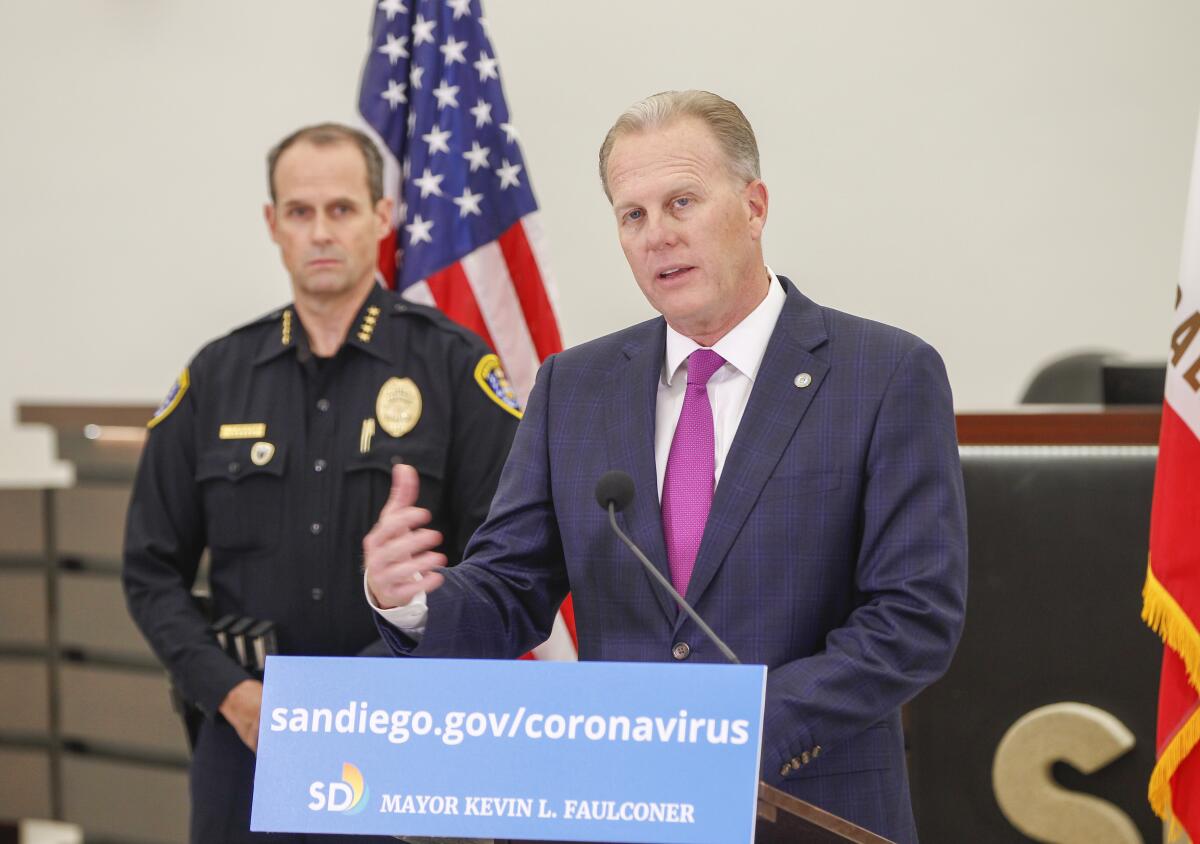San Diego mayor proposes deep cuts to close $250-million revenue gap due to coronavirus

SAN DIEGO — Plummeting tax revenue during the coronavirus outbreak has prompted San Diego Mayor Kevin Faulconer to propose sharp spending cuts in response to a $250-million gap in tax revenue.
The cuts would include closing municipal pools and reducing hours at libraries and recreation centers.
The mayor also proposes deep cuts to arts funding and more moderate reductions to tree trimming, graffiti eradication, code enforcement and the clearing of clogged drainage channels to prevent flooding.
The proposed spending plan would eliminate 350 jobs, but city finance officials said they expect the number of layoffs to be significantly lower as many displaced workers find other positions in San Diego’s 11,000-member city workforce.
The proposal avoids cuts to homelessness funding. No reductions are proposed for firefighters or police officers, and funding would remain steady for the Clean San Diego neighborhood anti-dumping program.
The cuts would help close a projected $250-million drop in tax revenue that city officials have estimated from the COVID-19 pandemic, which has hit San Diego’s finances especially hard because of the city’s heavy reliance on tourism and hotel tax revenue.
Faulconer is calling it the largest deficit in city history.
“COVID-19 has impacted all of us, and city government is no exception,” the mayor said. “This budget is fully balanced and makes responsible decisions today so we can enjoy a better tomorrow. We’re going to put the city in the strongest financial position possible to weather this crisis and emerge prosperous and thriving on the other side.”
The city is projected to lose about $109 million between the start of the pandemic and June 30. The mayor’s budget estimates that an additional $145 million will be lost during the new fiscal year, which begins July 1.
City finance officials said even more severe cuts could be needed if the projected revenue shortfall becomes larger than they now anticipate. They said it’s hard to predict when people will resume traveling to San Diego and filling the city’s thousands of empty hotel rooms.
The fate of several annual summer events will have a significant effect on the city’s revenue projections, officials said. They include San Diego Pride, Comic-Con, the Rock ’n’ Roll Marathon and the annual ESRI conference.
The proposed spending plan, which Faulconer unveiled Wednesday, is based on projections created March 30. City finance officials said updated projections will be used to create a May revision to the spending plan, which they said is likely to include deeper proposed cuts.
Though the proposal covers the fiscal year that starts July 1, it’s more of a 15-month budget than a yearly budget because of the pandemic’s enormous toll on city revenues this spring.
To close the estimated $109-million deficit during the ongoing budget year, the city would rely mostly on reserve funds and projections of excess cash from before the pandemic.
Nearly half the money would be $54 million from the city’s emergency reserve of $205 million — more than 25% of the city’s “rainy day” fund. An additional $28 million would come from excess equity, a surplus projected before the pandemic.
The rest of that gap would be closed with a hiring freeze, a prohibition against any new expenditures and eliminating a scheduled $12.8-million contribution to the emergency reserve to get it closer to the recommended level.
In the proposed budget for the new fiscal year, with a projected revenue gap of $145 million, another scheduled reserve fund contribution of $13.6 million would also be eliminated. In addition, the city would use its $12.2-million pension stabilization reserve to help close the gap.
All told, the pandemic’s effect on city reserves would be $92.6 million — $66.2 million in actual cash and $26.4 million in canceled contributions.
The remainder of the $145-million gap in the new fiscal year would be covered by the proposed budget cuts and some one-time sources, including $21 million from selling the city’s stadium site in Mission Valley to San Diego State.
Another one-time revenue source that Faulconer would use is $29.5 million in general fund revenue that the city is required to spend on infrastructure because of a 2016 ballot measure. The city can override that requirement in an emergency.
The proposed budget cuts would save the city an estimated $61.2 million during the new fiscal year.
Garrick writes for the San Diego Union-Tribune.
More to Read
Sign up for Essential California
The most important California stories and recommendations in your inbox every morning.
You may occasionally receive promotional content from the Los Angeles Times.











